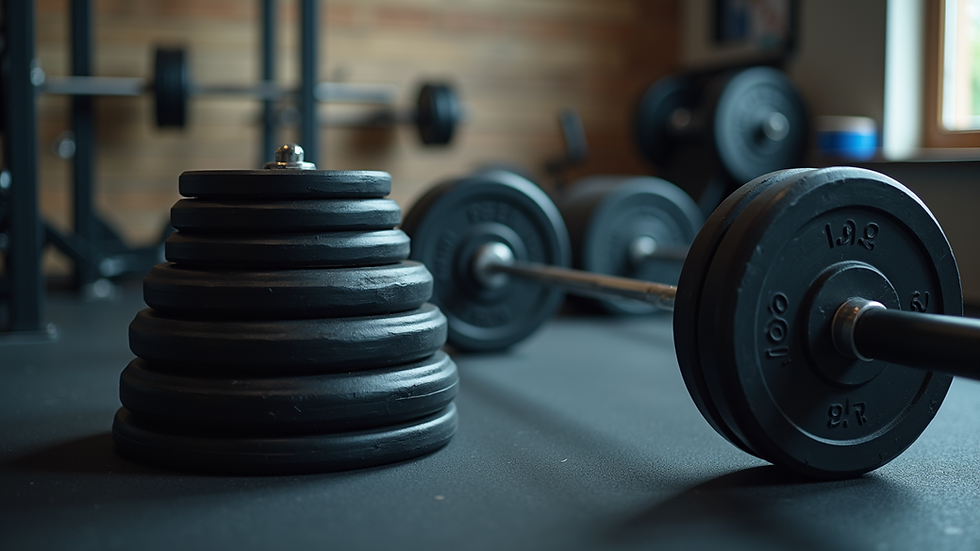REST-PAUSE WEIGHTLIFTING METHOD
- Moran Sciamama-Saghiv
- Aug 30
- 5 min read
The world of weightlifting is filled with various techniques and methods designed to maximize strength gains and muscle growth. One method that stands out is the rest-pause weightlifting method. This approach enables you to push your limits by adding short rest intervals into your lifting routine. In this blog post, you will discover the fundamentals of the rest-pause weightlifting method, how to implement it effectively, and the meaningful benefits it can bring to your training regimen.
Understanding the Rest-Pause Weightlifting Method
The rest-pause weightlifting method is a training technique that involves performing a set of exercises until you cannot lift anymore, taking a short break, and then continuing the set. This method intensifies your workouts, allowing you to lift heavier weights and effectively stimulate muscle growth.
The approach is simple: after reaching muscle failure on a particular exercise, you take a brief rest—typically around 10 to 20 seconds—before attempting to lift again. This short rest gives your muscles just enough recovery to knock out a few more reps, leading to greater strength gains and muscle growth.
The Science Behind Rest-Pause Weightlifting Method
The effectiveness of the rest-pause weightlifting method is backed by physiological principles. When you lift weights, you create micro-tears in your muscle fibers. This damage is crucial for muscle growth as it prompts your body to repair and strengthen those muscles. By integrating rest-pause training, you can extend the time your muscles are under tension, resulting in more significant adaptations.
Moreover, short rest intervals help recruit more muscle fibers, especially fast-twitch fibers responsible for explosive strength and power. This recruitment is vital for athletes wanting to enhance their performance in sports requiring quick bursts of energy.
Benefits of the Rest-Pause Weightlifting Method
Increased Muscle Hypertrophy: By pushing your muscles to their limits and incorporating short rest periods, studies show you can experience up to 25% greater muscle growth than with traditional training methods.
Improved Strength Gains: Many lifters find they can increase their lifting capacity by 10-15% over measurable periods when implementing rest-pause techniques.
Time Efficiency: For those with tight schedules, this method allows for an effective workout in about 30 minutes. You can achieve better results without spending hours in the gym.
Enhanced Mental Toughness: Engaging in longer sets builds mental resilience, an essential trait for long-term success in fitness and beyond.
Variety in Training: Adding the rest-pause weightlifting method into your routine can shake things up, preventing workout monotony and keeping you motivated.
How to Implement the Rest-Pause Weightlifting Method
Now that you understand the benefits, here’s how to effectively implement the rest-pause weightlifting method in your training.
Step 1: Choose Your Exercises
Start with compound exercises that target multiple muscle groups. Effective options include:
Squats: Engaging the legs and core, shown to increase leg muscle mass by 15%.
Deadlifts: Great for overall strength, this move can contribute to up to a 20% increase in back strength.
Bench Press: A fundamental movement for building chest and tricep muscles.
Overhead Press: Ideal for shoulder strength and stability.
Rows: Essential for back development.
Step 2: Determine Your Rep Range
For optimal results with the rest-pause weightlifting method, aim for a rep range of 6 to 12 repetitions. This range is effective for promoting muscle hypertrophy while still allowing heavy lifting.
Step 3: Perform Your Set to Failure
Begin your set by lifting until you reach muscle failure. Muscle failure occurs when you cannot perform another rep with good form. Pushing yourself during this initial phase maximizes the method's effectiveness.
Step 4: Take a Short Rest
Once you reach failure, take a quick rest of 10 to 20 seconds. Use this time to recover and prepare mentally for the next lifting attempt.
Step 5: Continue the Set
After resting, attempt to lift the weight again. You may be able to perform a few more reps, stimulating further muscle growth. Repeat this process for 2 to 4 rest-pause sets, based on your fitness level and goals.
Step 6: Monitor Your Progress
Record your weights, reps, and how you felt during each session in a workout journal. Tracking ensures you continue to adjust your program as your strength improves.

Tips for Success with the Rest-Pause Weightlifting Method
To maximize your use of the rest-pause weightlifting method, keep these tips in mind:
Focus on Form: Proper form is crucial. Bad technique increases injury risks and hinders progress.
Listen to Your Body: Be aware of how this method affects you. If you feel overly fatigued or uncomfortable, adjust your weights or rest lengths.
Incorporate Variety: Alternate the rest-pause weightlifting method with other techniques to avoid plateaus.
Stay Hydrated: Proper hydration supports peak performance. Drink enough water before, during, and after workouts.
Fuel Your Body: Nutrition is key. Ensure adequate protein and caloric intake to foster muscle recovery and growth.
Common Mistakes to Avoid
While the rest-pause weightlifting method can be very effective, steer clear of these common pitfalls:
Neglecting Warm-Up: Always warm up to prepare your muscles and joints for intense exercise.
Overtraining: Monitor overall training volume to avoid burnout. Ensure you get sufficient recovery time between sessions.
Ignoring Recovery: Prioritize rest days. Active recovery techniques like stretching or foam rolling can enhance recovery.
Rushing Through Sets: Use your rest intervals wisely. Hurrying can lessen the method’s effectiveness and lead to poor outcomes.
Sticking to the Same Weights: Challenge yourself by regularly increasing your weights or adjusting rep ranges to ensure continual progress.

Sample Workout Routine Using the Rest-Pause Weightlifting Method
Here’s a sample workout routine designed around the rest-pause weightlifting method:
Day 1: Upper Body
Bench Press: 3 sets of 6-8 reps (rest-pause)
Bent-Over Rows: 3 sets of 6-8 reps (rest-pause)
Overhead Press: 3 sets of 6-8 reps (rest-pause)
Pull-Ups: 3 sets to failure (rest-pause)
Day 2: Lower Body
Squats: 3 sets of 6-8 reps (rest-pause)
Deadlifts: 3 sets of 6-8 reps (rest-pause)
Leg Press: 3 sets of 6-8 reps (rest-pause)
Calf Raises: 3 sets to failure (rest-pause)
Day 3: Full Body
Clean and Press: 3 sets of 6-8 reps (rest-pause)
Dumbbell Lunges: 3 sets of 6-8 reps (rest-pause)
Push-Ups: 3 sets to failure (rest-pause)
Plank: 3 sets for time (rest-pause)
Unlocking Your Full Potential
The rest-pause weightlifting method is a powerful training technique that can guide you past plateaus, enhance muscle growth, and promote overall strength. By incorporating this method into your routine, you can get the most out of your workouts and achieve your fitness goals more efficiently.
Always prioritize proper form, pay attention to your body, and ensure ample recovery. With dedication and consistency, you will be well on your way to reaching your peak performance in the gym.

Services by Dr. Moran Sciamama-Saghiv:





Comments